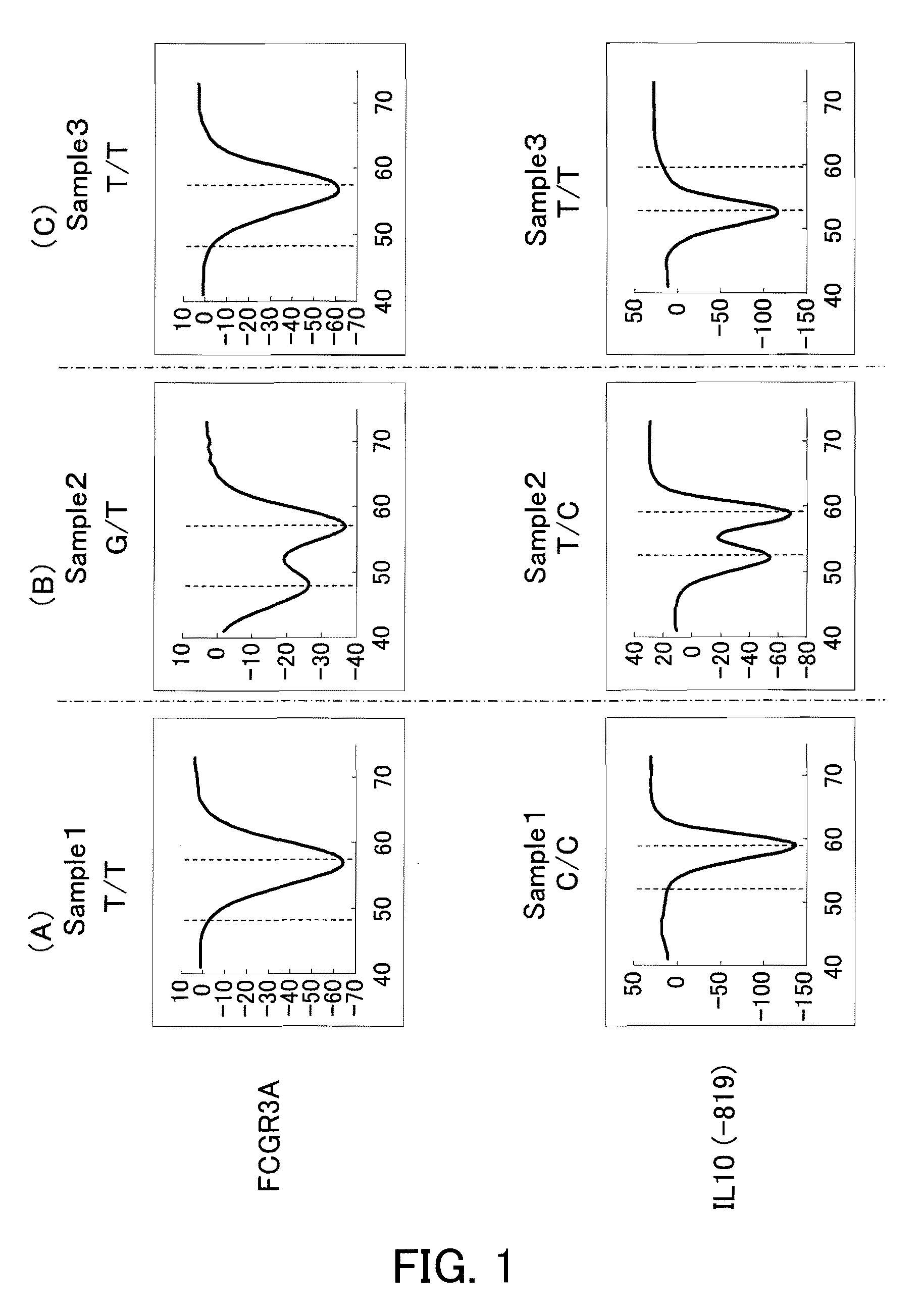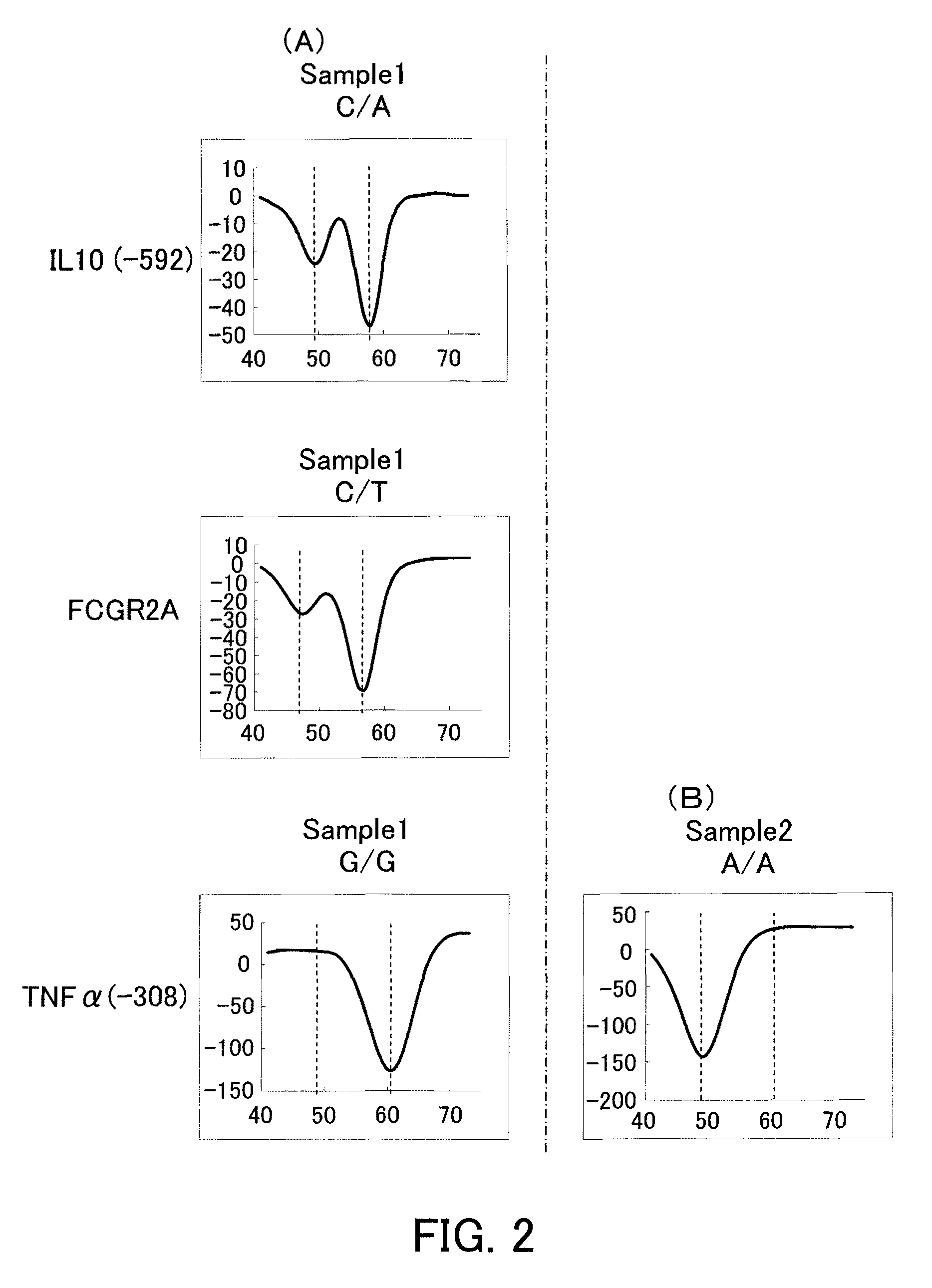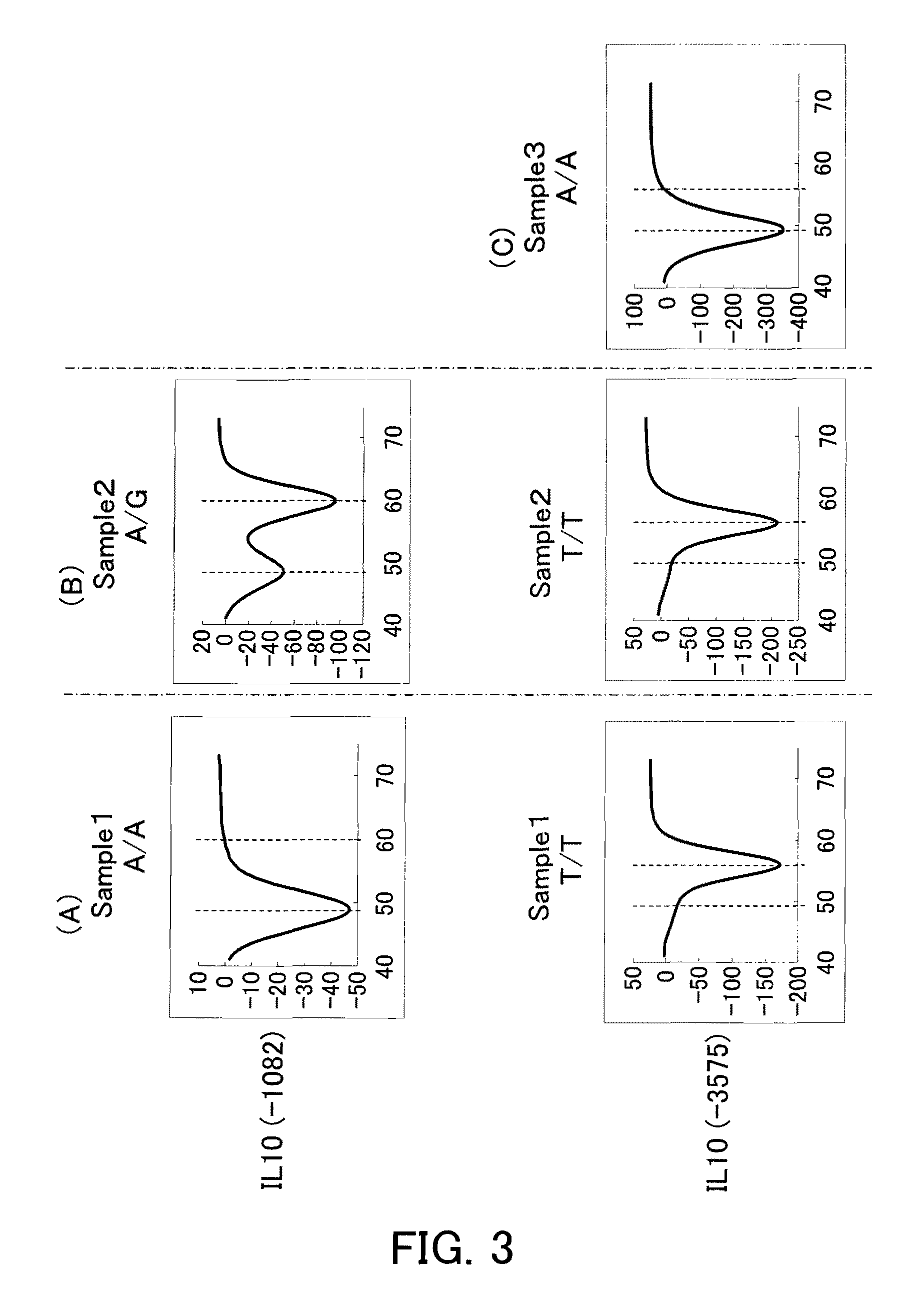Probes for detecting immune-related gene polymorphisms and applications of the same
a technology for immune-related genes and polymorphisms, applied in the field of probes for detecting polymorphisms of immune-related genes, can solve the problems of difficult methods, difficult treatment of amplification products, and troublesome detection, and achieve excellent reliability
- Summary
- Abstract
- Description
- Claims
- Application Information
AI Technical Summary
Benefits of technology
Problems solved by technology
Method used
Image
Examples
example 1
Detection of FCGR3A Polymorphism and IL-10 (−819) Polymorphism
[0153]Using probes of the present invention, FCGR3A polymorphisms and IL-10 (−819) polymorphisms were detected by a Tm analysis.
[0154]Blood was collected using EDTA blood collection tubes from 3 healthy subjects whose FCGR3A polymorphism and IL-10 (−819) polymorphism were known (Sample 1 to Sample 3). The FCGR3A polymorphism and the IL-10 (−819) polymorphism of each sample were as follows.
[0155]
FCGR3A PolymorphismsIL-10 (−819) PolymorphismsSample 1T / TC / CSample 2G / TT / CSample 3T / TT / T
[0156]Each sample (10 μL) was mixed with 70 μL of the following test sample dilution 1, and the mixtures (10 μL each) were further mixed with 70 μL of the following test sample dilution 2. Each mixture (17 μL) was heated at 95° C. for 10 minutes and introduced into 46 μL of the following PCR reaction solution to carry out PCR. The PCR included a treatment at 95° C. for 60 seconds and then repeating 50 times a cycle of heating at 95° C. for 1 sec...
example 2
Detection of FCGR2A Polymorphism, IL-10 (−592) Polymorphism and TNF α Polymorphism
[0162]Using probes of the present invention, an FCGR2A polymorphism, an IL-10 (−592) polymorphism and TNF α (−308) polymorphisms were detected by a Tm analysis.
[0163]Blood was collected using an EDTA blood collection tube from a healthy subject whose FCGR2A polymorphism, IL-10 (−592) polymorphism and TNF α (−308) polymorphism were known (Sample 1). A plasmid having a TNF α gene whose TNF α (−308) polymorphism was a homozygote (A / A) was prepared (Sample 2). The FCGR2A polymorphism, the IL-10 (−592) polymorphism and the TNF α (−308) polymorphism of each sample were as follows.
[0164]
FCGR2AIL-10 (−592)PolymorphismPolymorphismTNFa PolymorphismSample 1C / TC / AG / GSample 2——A / A
[0165]Sample 1 (10 μL) was mixed with 70 μL of the test sample dilution 1 described above, and the mixture (10 μL) was further mixed with 70 μL of the test sample dilution 2 described above. This mixture (17 μL) was heated at 95° C. for 10...
example 3
Detection of IL-10 (−1082) Polymorphism and IL-10 (−3575) Polymorphism
[0169]Using probes of the present invention, IL-10 (−1082) polymorphisms and IL-10 (−3575) polymorphisms were detected by a Tm analysis.
[0170]Blood was collected using an EDTA blood collection tube from a healthy subject whose IL-10 (−1082) polymorphism and IL-10 (−3575) polymorphism were known (Sample 1). Moreover, using a GFX Genomic Blood DNA Purification Kit (trade name, manufactured by GE Healthcare Bioscience), a genome whose IL-10 (−1082) polymorphism and IL-10 (−3575) polymorphism were known was purified, and diluted 10 fold to give Sample 2. In addition, a synthetic DNA whose IL-10 (−3575) polymorphism was a homozygote (A / A) was prepared (Sample 3). The IL-10 (−1082) polymorphism and the IL-10 (−3575) polymorphism of each sample were as follows.
[0171]
IL-10 (−1082) PolymorphismIL-10 (−3575) PolymorphismSample 1A / AT / TSample 2A / GT / TSample 3—A / A
[0172]Sample 1 (10 μL) was mixed with 70 μL of the test sample di...
PUM
| Property | Measurement | Unit |
|---|---|---|
| detection wavelength | aaaaa | aaaaa |
| detection wavelength | aaaaa | aaaaa |
| detection wavelength | aaaaa | aaaaa |
Abstract
Description
Claims
Application Information
 Login to View More
Login to View More - R&D
- Intellectual Property
- Life Sciences
- Materials
- Tech Scout
- Unparalleled Data Quality
- Higher Quality Content
- 60% Fewer Hallucinations
Browse by: Latest US Patents, China's latest patents, Technical Efficacy Thesaurus, Application Domain, Technology Topic, Popular Technical Reports.
© 2025 PatSnap. All rights reserved.Legal|Privacy policy|Modern Slavery Act Transparency Statement|Sitemap|About US| Contact US: help@patsnap.com



